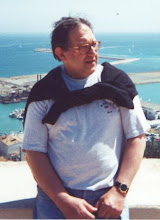Hoy entramos en la tercera fase del verbo "to be" que, cómo recordaréis, es a la vez el verbo "ser" y "estar". En nuestras sesiones previas, vimos en primer lugar que hacer una frase afirmativa con este verbo consiste en decir primero quien es o está - o sea el "sujeto" - (ej. I , he, the doctor, etc.), luego viene el verbo "to be" en su forma apropiada - o sea la "acción" -(ej. am, is o are, etc.) y, finalmente, terminamos la frase con un "complemento", si hiciera falta (ej. a teacher, at home, etc.) También vimos que para hacer una frase negativa con el mismo verbo, solamente tenemos que añadir "not" al verbo (ej. I am not, he is not, the students are not, etc.)
HOY, HAREMOS PREGUNTAS con el verbo to be. Es realmente muy sencillo. lo único que debemos hacer es invertir el orden del sujeto y del verbo. Miremos esta frase:
The teacher is English (El profesor es inglés)
Aquí, el sujeto es "The teacher" y el verbo es "is", de modo que invirtiendo el orden tendremos la pregunta: Is the teacher English? (¿Es el profesor Inglés?) o bien lo que es más normal en castellano (¿Es inglés el profesor?)
A continuación veremos unas preguntas con los diferentes pronombres:
Am I .....? - Am I a teacher? (¡Soy (yo) profesor?)
Are you.....? - Are you a student? (¿Eres (tú) estudiante?)
Is he .....? - Is he Spanish? (¿Es (él) español?)
Is she .......? - Is she a secretary (¿Es (ella) secretaria?)
Is it ......? - Is it a television? (Es (ello) un televisor?)
Are we .......? - Are we workers? (¿Somos (nosotros) trabajadores?)
Are you ......? - Are you doctors ? (Soys (vosotros) /o bien /son (ustedes) médicos?)
Are they ......? - Are they German (¿Son (ellos) alemanes?)
Ahora, como ejercicio práctico, copiar y pegar, o imprimir, este texto y rellenar los espacios con la forma apropiada del verbo to be:
John .......... a teacher. I .............. a doctor. María ......... a student. John and María ......... from Spain. I ....... (neg) ........ from Spain, I ......... from England. We ........... in Barcelona. We ......... (neg) ......... interested in football. We ......... interested in Catalunya.
and you? (¿y tú?)
........ you Spanish or ........ you Catalan? ....... you a teacher or ....... you a student?
....... John a student or ........ he a teacher? Am I a doctor or ........ I an actor? ........ Maria a student or is she a teacher? ......... I from England? ........ John from England? ....... Maria from Spain? ......we interested in football? ......... we interested in Catalunya?
Ahora conteste a las preguntas (in English..... of course - :-) - En inglés !por supuesto!
En nuestra próxima sesión os pondré las respuestas. Si no puedes esperar, mándame un mail a (joesabadell@yahoo.es) con tus respuestas y lo corregiré.
Para finalizar recordaremos las contracciones que hemos aprendido y sus correspondiente pronunciación:
I am = I'm (áim)
You are = You're (iúúr- "u" larga)
He is = He's (híís - "i" larga, s suave)
She is = She's (shíís - "i" larga, s suave)
It is = It's (ets)
We are = We're (wíír - "i" larga)
You are = You're (iúúr - "u" larga)
They are = They're (dèir - "è" larga, abierta, como la è catalana)
PRACTICA ESTAS CONTRACCIONES REPITIÉNDOLAS UNA Y OTRA VEZ.
SI TU NIVEL TE LO PERMITE Y QUIERES EXPLORAR DIFERENTES ASPECTOS DEL IDIOMA - PRUEBA ESTA WEB
http://englishonline.sites.uol.com.br/english/basic.htm
SEE YOU SOON!
Suscribirse a:
Enviar comentarios (Atom)

No hay comentarios:
Publicar un comentario